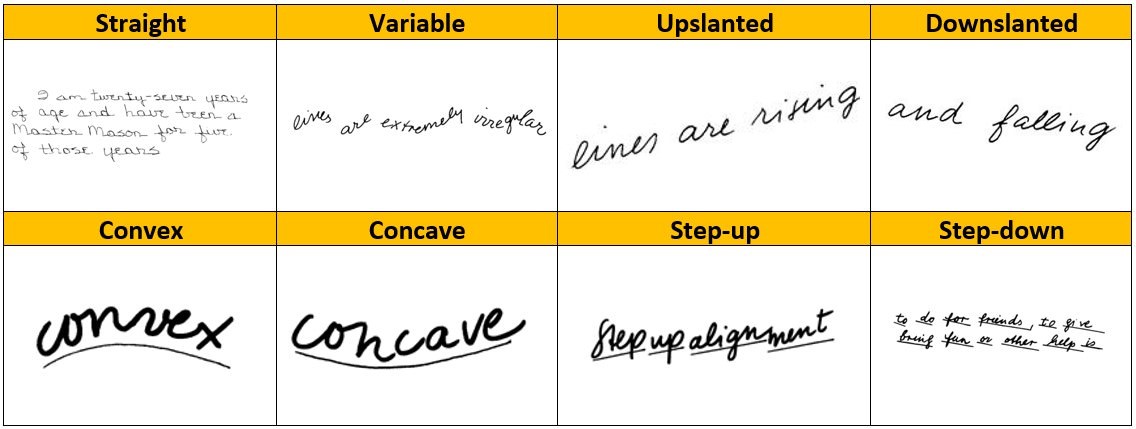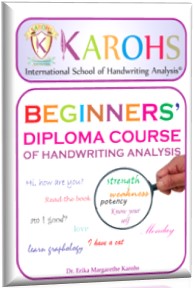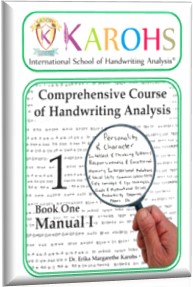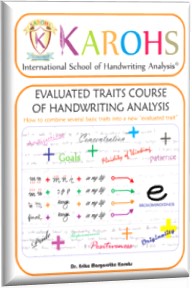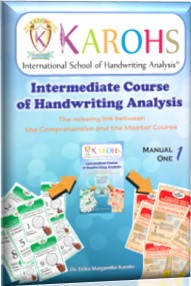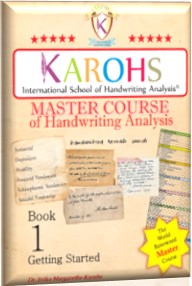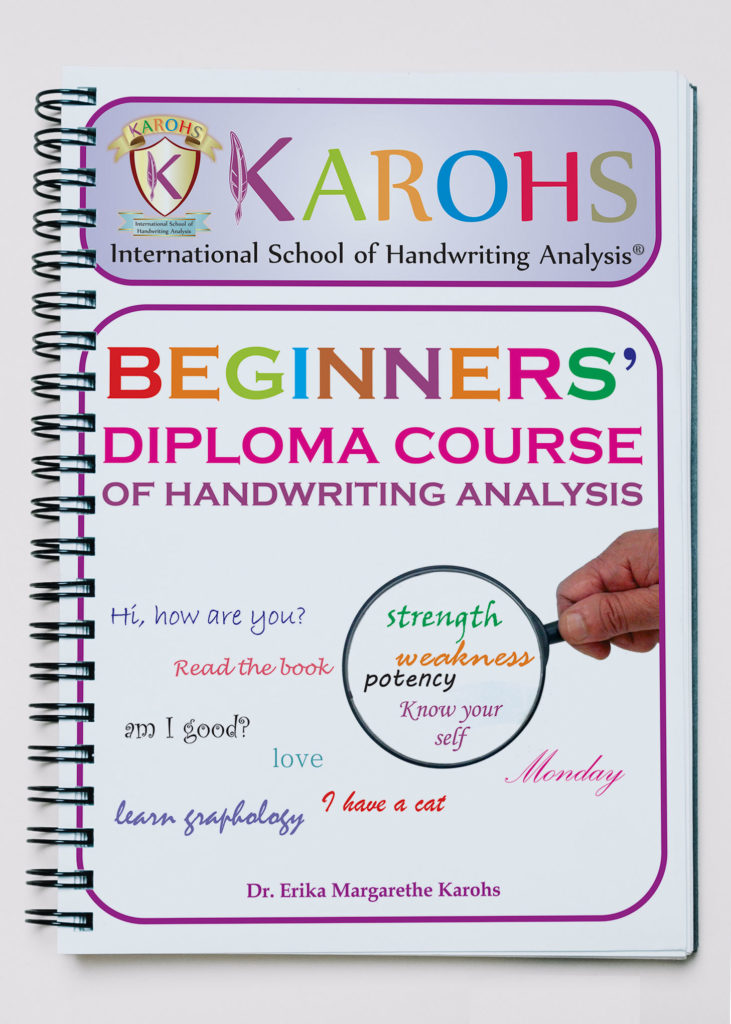
Free Article about Handwriting Analysis
From “Sunday Lessons III”
- Lesson #2: Airstrokes& Alignments
AIRSTROKES
Magdalena Ivanovic, one of the most inspirational (and unappreciated) German graphologists, left a wealth of unexplored graphological research information.
Among other indicators, she discovered the airstroke or immaterial stroke. “These frictionless immaterial lines,” she postulates,” represent the intellectual.” She emphasizes that “this is not disconnected writing, but only a writing of which parts are invisible. It is used when the writer’s fast mind believes that intellect can do a better job than physical activity.” (Frank Victor: A Personality Projection.)
Airstrokes are connecting lines from one zone to another in which the writing instrument has been slightly lifted off the paper. Although the ductus (writing line) is invisible, the actual writing movement has continued. An important characteristic is that the direction of the interrupted stroke remains constant. Furthermore, both stroke remainders must be visible and point toward each other.
In fast writing, there may be an extremely fine hairline. This is still an airstroke.

Occasional airstrokes facilitate speed of writing and are one of the indicators of above average intelligence. They manifest mental perspicuity, associative skills, and logical thinking ability.
Airstroke writers are quick-witted and let their intellect do the job for them, rather than toiling physically. They are the kind of people who dislike friction in their work and interpersonal relationships. They are, as a rule, intellectually oriented and want to pursue their mental work without impediments and abrasions.
In writing, upward movements cause a certain amount of drag as the writing instrument pushes slightly into the paper. Airstroke writers eliminate it by lifting the pen off the paper.
Airstrokes in moderate degree show that the writer is flexible in his responses and adapts easily to people and circumstances (again to avoid friction).
Airstrokes in strong degree reveal that the writer takes the easy way out; he is too easily swayed. He may agree simply to avoid arguments and as a result, may appear unpredictable.
ALIGNMENT
Letters, words and lines are symbolic for various time spans in the writer’s life. Their alignment (horizontal direction) reveals the writer’s inner feelings and outward behavior.
It shows how he approaches a project and how he carries it through. It illustrates planning ability and points to optimism or negativism, respectively. Most importantly, it signals the writer’s degree of flexibility and adaptability.
As symbols of time, letters manifest very short and words somewhat longer periods. Lines typify still longer spans of time. The lines of a whole page or of several pages are synonymous with years.
Alignment exposes the writer’s attitude during each particular block of time. For instance, if letter alignment is very irregular, it attests to frustration and a very quickly changing attitude.
Irregular word alignment is less serious because the writer’s mood alters over a somewhat longer period of time.
Evaluation of alignment is important because it is one of the handwriting characteristics that is extremely difficult to change at will.
There are eight main categories of alignment:
![]()
- Alignment of lines straight
Lines appear straight as measured by the eye. There may be minute variations up or down.
The writer is levelheaded and has realistic controls over his behavior. He exhibits an evenly balanced mood. He exercises self-control over his emotions, desires and actions. He sees and keeps things in perspective. He has established principles to which he consistently adheres. He is reliable and internally motivated. He is persevering and steadfast in everything he does. His performance is steady and he is single-minded in pursuing his goals. He finds achievement rewarding in itself. He is able to mentally schedule ahead and each goal he sets is carefully planned. He works reliably and emphasizes method and order when he is in command. Once he has set up his schedule, it annoys him to have to rework it or make last minute changes.
The writer is competitive for the sake of winning. He becomes irritated by interference and delays. To a degree, he is selfish. He utilizes his energies and resources mainly toward his own personal goals.
Extremely straight alignment signifies over-control, compulsiveness and rigidity. The writer is extremely tense about regulating his life according to established rules and lacks adaptability.

- Variable alignment
Slightly variable alignment points to self-directive ability that lacks rigidity. The writer sees and keeps things in perspective and rarely loses emotional control.
Slightly variable alignment is the most frequent category of all. Writers producing them are adaptable. They are outer-directed and susceptible to being influenced by circumstances and other people.
In negative writing, variable writing suggests moodiness and inconsistency.
Extremely irregular alignment implies moodiness and emotional unreliability.
![]()
- Upslanted alignment
Slightly rising lines are ONE of the indicators of speed. Graphologically, in high form level writing, this interprets as diligence, ambition, zeal and enthusiastic involvement.

Extremely rising lines mean lack of mental control.
- Downslanted alignment
Downslanted lines are often one of the indicators of slowness in writing.
In high form level writing, they point to lack of energy, discouragement, or melancholy.

If this is due to poor physical health, there are usually stunted or incomplete letters and poor pressure.
In low form level writing they point to laziness and indolence.
- Convex alignment
Convex alignment interprets as mental and/or physical fatigue or lack of continuing motivation.

Such writers commence projects with a normal level of energy, but once into the undertaking, their interest wanes. They need outside sources or other people to motivate them to continue.
- Concave alignment
Such writers are project finishers. While involved in a project, they usually experience periods of discouragement but their motivation makes them go ahead despite difficulties and dejection.

In time, they feel again increasing enthusiastic and more involved and continue the tasks.
- Step-up alignment
This means constantly recurring self-control expended for continuance of a project. It is rarely found consistently in a writing but rather occurs sporadically throughout the page.

Step-up alignment exposes an inner state of excitement which threatens to get out of control. In order to keep himself in line, the writer expends mental energy which is lost for more productive activities.
- Step-down alignment
A writing line descending by steps expresses gradually diminishing enthusiasm and increasing negativism on the part of the writer.

He expends energy to keep himself working on a project even though he may be discouraged or physically fatigued. If this continues over a long period of time, this becomes a serious drain on the individual’s inner resources.
Words sinking at the end of the line
If words sink at the end of the line, this is not connected to negativism or discouragement. It is related to lack of organizational ability.
![]()
Words sinking at the end of the line are not related to negativism. They are evidence of poor organizational ability.
The writer shows poor planning ability. He misjudges time and materials necessary to complete a job. Initially, he tends to be extravagant and wasteful with both. When he realizes that he cannot finish a project in the allotted time, he tries to complete too much work at the last minute with too few resources.
The writer finds it impossible to squeeze the last letters onto the line and so inserts them downwards. In this manner the line is artificially lengthened. This illustrates poor planning.
Literature:
Erika M. Karohs, “Handwriting Analysts Companion, Comprehensive Explanations and Illustrations for (Almost) All Handwriting Indicators,” volume 1 available at https://karohs.com
————————————————————-
Tidbits
One of Ivanovic’s discoveries is the indicator for “Aerger und Verdriesslichkeit” (the closest translation would be “Angriness” and a melancholy, sullen state of mind).
The trait combination is revealed by a combination of so-called “antagonistic” strokes – a curved downstroke turning at a sharp angle into a straight upstroke. As an example Ivanovic includes the handwriting of the 19th century German philosopher and pessimist Arthur Schopenhauer.

Ivanovic wrote that interestingly, after the peace treaty of Versailles, this indicator appeared in many German handwritings.
Normally, she states, this stroke is not common because it interrupts fluidity and normal forward movement of the stroke. At the point where the rounded stroke turns into the angle an almost complete stop of the writing movement is required.
Since I read about this stroke combination, it was often in the back of my mind, but I had never found it in a modern handwriting and I finally concluded that it must be one of those extinct strokes.
To my surprise, I recently found out that this is not true. Look at the great example in the signature of the President of “Health Resources” below.
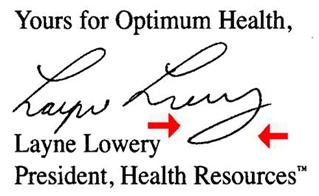
In one of the future Sunday lessons, I will introduce you to a similar “antagonistic” strokes combination revealing the traits “fearfulness” and “needless worries.”
I hope you enjoy “Sunday Lessons Series III”. If you have any questions or would like to recommend topics, please feel free to email me at info@karohs.com
I hope you enjoy “Sunday Lessons Series III”. If you have any questions or would like to recommend topics, please feel free to email me at info@karohs.com
See detail courses programs (click the image below):
Beginners Diploma Course of Handwriting Analysis
Many people are interested in handwriting analysis but don’t want to enroll in a full-fledged study course right away. The Beginners Course is a perfect way to become familiar with the fascinating science of handwriting analysis. It teaches 40 personality traits – enough to gain personal insight into yourself and, on a basic level, to “read” other people’s writings.
Course Materials for the Beginner Course
- Beginners Diploma Course Manual
- Dictionary of Personality Traits
- Self Tests Manual
- Profile Analysis Work Sheets
- Model answers
- Online Support Form
- Final diploma test
HOME
COURSE
BOOKS
Copyright © 2018 the KAROHS International School of Handwriting Analysis®. All rights reserved.
No image or portion of this website may be copied or reproduced without written permission.

